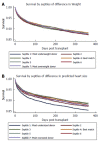Donor to recipient sizing in thoracic organ transplantation
- PMID: 27011913
- PMCID: PMC4801791
- DOI: 10.5500/wjt.v6.i1.155
Donor to recipient sizing in thoracic organ transplantation
Abstract
Donor-to-recipient organ size matching is a critical aspect of thoracic transplantation. In the United States potential recipients for lung transplant and heart transplant are listed with limitations on donor height and weight ranges, respectively. Height is used as a surrogate for lung size and weight is used as a surrogate for heart size. While these measures are important predictors of organ size, they are crude surrogates that fail to incorporate the influence of sex on organ size. Independent of other measures, a man's thoracic organs are approximately 20% larger than a woman's. Lung size can be better estimated using the predicted total lung capacity, which is derived from regression equations correcting for height, sex and age. Similarly, heart size can be better estimated using the predicted heart mass, which adjusts for sex, age, height, and weight. These refined organ sizing measures perform better than current sizing practice for the prediction of outcomes after transplantation, and largely explain the outcome differences observed after sex-mismatch transplantation. An undersized allograft is associated with worse outcomes. In this review we examine current data pertaining to size-matching in thoracic transplantation. We advocate for a change in the thoracic allocation mechanism from a height-or-weight-based strategy to a size-matching process that utilizes refined estimates of organ size. We believe that a size-matching approach based on refined estimates of organ size would optimize outcomes in thoracic transplantation without restricting or precluding patients from thoracic transplantation.
Keywords: Heart transplant; Lung transplant; Organ allocation; Organ size; Size mismatch.
Figures









References
-
- Reed RM, Eberlein M. Sizing considerations in lobar lung transplantation. Transpl Int. 2014;27:e132–e133. - PubMed
-
- Eberlein M, Arnaoutakis GJ, Yarmus L, Feller-Kopman D, Dezube R, Chahla MF, Bolukbas S, Reed RM, Klesney-Tait J, Parekh KR, et al. The effect of lung size mismatch on complications and resource utilization after bilateral lung transplantation. J Heart Lung Transplant. 2012;31:492–500. - PubMed
-
- Eberlein M, Diehl E, Bolukbas S, Merlo CA, Reed RM. An oversized allograft is associated with improved survival after lung transplantation for idiopathic pulmonary arterial hypertension. J Heart Lung Transplant. 2013;32:1172–1178. - PubMed
Publication types
Grants and funding
LinkOut - more resources
Full Text Sources
Other Literature Sources

